Samaaro + Your CRM: Zero Integration Fee for Annual Sign-Ups Until 30 June, 2025
- 00Days
- 00Hrs
- 00Min
Event registration and ticketing are not merely administrative processes but integral components of creating exceptional event experiences. The way organizers communicate, streamline the registration process, engage attendees, and leverage data can significantly impact the overall success and satisfaction of an event. In fact, “a survey conducted among event marketers revealed that 49% of them see participant engagement as the most important factor for a successful event”. In this article, we will explore various aspects of event registration and ticketing software that contribute to crafting memorable experiences for both organizers and attendees.
Note – This article is broken down in 3 parts to explain the Use of Event Registration and Ticketing Software.
A successful event begins well before attendees arrive at the venue. Pre-event communication plays a crucial role in setting expectations, conveying important information, and creating a personalized experience for participants. By leveraging the power of event registration and ticketing software, organizers can go beyond the basics and maximize event experiences right from the start.
Below are some ways in which organizers can start enhancing the event experience through ticketing and registration software.
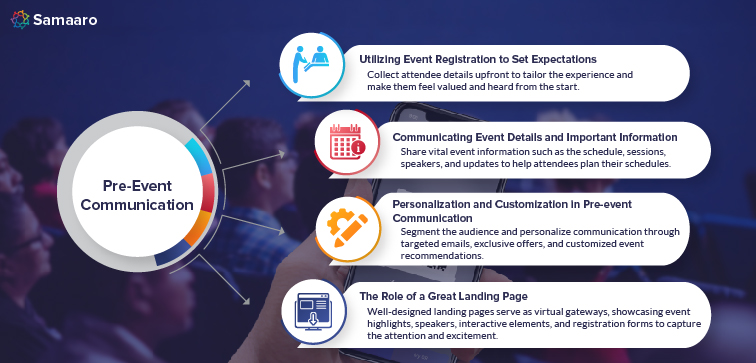
Once the essential aspects of pre-event communication have been established it is important to move on to creating a seamless registration process.
A seamless registration process is key to maximizing event participation and ensuring a positive attendee experience. In this section, we will explore various elements that contribute to a smooth registration process, from user-friendly forms and interfaces to integrating registration with CRM and marketing tools. Let’s dive in!
(Use Full Tip: Clear instructions, minimal fields, and logical flow contribute to a seamless experience, increasing the likelihood of successful registrations.)
A seamless registration process sets the stage for enhancing attendee engagement during an event. When attendees experience a smooth and hassle-free registration, they are more likely to approach the event with a positive mindset and enthusiasm.
Engaged attendees are at the heart of any successful event. Creating meaningful interactions and fostering a sense of connection contribute to a memorable attendee experience. From customizing confirmation emails and tickets to providing event updates and reminders, organizers can keep attendees informed and excited. Leveraging social media and online communities further amplifies engagement by creating a platform for interaction and networking. Additionally, promoting referrals and social sharing by attendees generates buzz and expands the event’s reach.
The image below explores the diverse avenues of enhancing attendee engagement and how it can lead to an immersive and rewarding event experience.
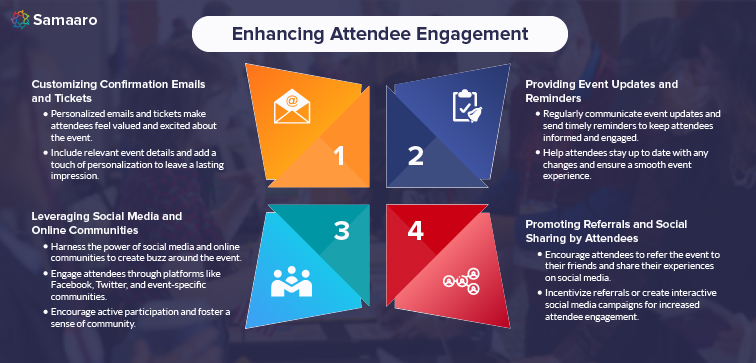
Delivering personalized experiences is a hallmark of exceptional events. By understanding attendees’ preferences and catering to their unique needs, organizers can create an unforgettable journey for each participant. Here are key strategies to provide customized experiences:
By paying attention to these small details, organizers can create tailored experiences by incorporating Ticketing and Registration in the event. Another crucial aspect of enhancing attendee engagement during an event is to focus on the on-site check-in experience.
Efficient check-in is essential to ensure attendee satisfaction and create a positive first impression. From streamlining the process to utilizing technology for fast and efficient check-ins, organizers can minimize wait times and enhance attendee satisfaction. By prioritizing these aspects, attendees can swiftly enter the event and immerse themselves in the activities without any unnecessary delays.
Below given are some key strategies to optimize the check-in process:
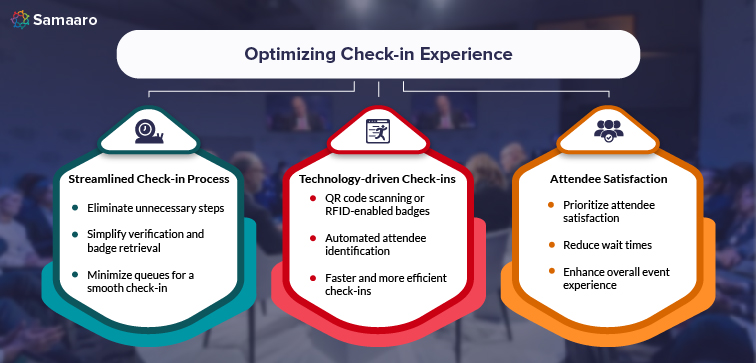
Efficient check-in is essential to ensure attendee satisfaction and create a positive first impression. However, the attendee engagement doesn’t end with the on-site check-in experience. Now, comes the last but an equally important step – Post Event use of Event Ticketing and Registration Software.
Even after the event concludes, the journey with attendees continues. Post-event follow-up and engagement play a crucial role in nurturing relationships and creating a lasting impact. In this section, we explore key strategies to keep attendees engaged and maintain their enthusiasm beyond the event itself. From expressing gratitude to gathering feedback and offering exclusive benefits, these practices contribute to a memorable post-event experience and set the stage for future interactions. Let’s delve into the essential elements of post-event follow-up and engagement to maximize attendee satisfaction and build a strong community around your events.
Wait! It does not end at post event follow up and engagement, through the vast amount of data collected by following all the above given parts, you now have an ocean of data to make your next event a huge success.
In today’s data-driven world, organizations have access to vast amounts of information that can be harnessed to drive continuous improvement. This is particularly relevant in the context of event management, where data analysis can provide valuable insights into registration and ticketing processes, enabling organizers to identify areas for improvement and make data-driven decisions for future events.
Some ways of leveraging this data :
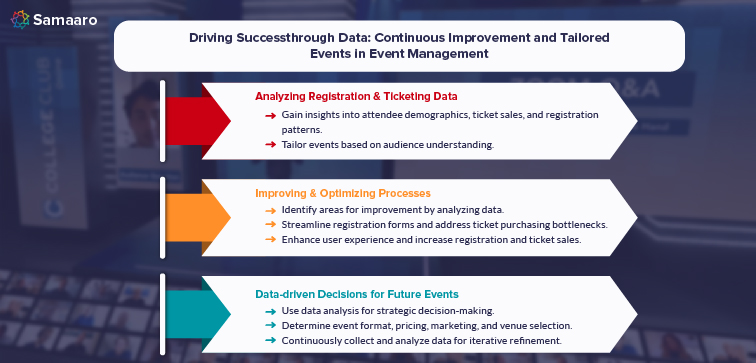
In conclusion, event registration and ticketing play a vital role in creating exceptional event experiences. From pre-event communication to on-site check-in, attendee engagement, and post-event follow-up, each aspect contributes to the overall success and satisfaction of an event. By leveraging the power of data and incorporating effective strategies, event organizers can continuously improve their processes, tailor events to audience preferences, and drive greater overall success.
To achieve these goals, Samaaro’s Ticketing and Registration Solution offers a comprehensive platform that streamlines the entire event management process. With Samaaro, you can effortlessly handle event registration, enhance attendee engagement, optimize the check-in experience, and gather valuable data for continuous improvement. Samaaro’s user-friendly interface, personalized communication options, and seamless integration with CRM and marketing tools provide organizers with the tools they need to create memorable event experiences.
Don’t settle for average events. Choose Samaaro’s Ticketing and Registration Solution and unlock the full potential of your events. Drive success, tailor experiences, and create unforgettable memories. Start using Samaaro today and take your event management to new heights.
Sponsors have always been an integral part of event planning, playing a critical role in supporting and enriching events. Sponsors serve a significant part in the success of events, and their engagement extends far beyond financial assistance. They provide knowledge, industry insights, and essential resources to the event, which improves the overall event experience for attendees. Sponsors demonstrate their dedication to community participation, brand loyalty, and corporate social responsibility by investing in events. Sponsors, in essence, serve as the events’ backbone, encouraging their growth, influence, and long-term viability.
But in return, we need to understand their objectives from participating in the event. It could be to generate leads; it could be to create brand awareness or may be just part of their CSR. Nevertheless, they expect a return on their investment. What if we told you there’s a way to increase the value of your sponsors even more? Event organisers may create tactics that not only benefit sponsors but also improve the entire event experience for attendees by recognising the importance of sponsors and their aims.
Let’s explore some strategies in detail, ensuring that sponsors can maximize their participation and achieve their desired outcomes in hybrid events.
1. Hosting Hybrid Events
Hybrid events, increases the impact of your events and opens new opportunities for sponsors. Why simply hold traditional in-person events; when you can use the potential of hybrid events to increase sponsor ROI, broaden reach, and create amazing moments for every individual involved. Don’t believe us, here’s a recent report that shows, “50.7% of event marketers surveyed believe that all live events in the future will include some form of digital components.”
2. Give Sponsors Their Own Digital Footprint
Brochures and catalogues are no longer satisfactory for captivating attendees. Provide sponsors with their own digital presence to ensure they stand out. Within the event platform, create a dedicated sponsor page or microsite that includes a visually appealing product gallery, a resource centre, and engaging material. This approach will assist sponsors in efficiently showcasing their products, increasing brand awareness, and encouraging consumers to connect with their information.
3. Implement Multiple Lead Capturing Alternatives
By providing a variety of lead capturing options, sponsors will be able to interact with potential prospects more efficiently. On the sponsor page, provide choices such as a meeting calendar, a “enquire now” button, or a “get in touch with the team” function. By providing different touchpoints, attendees may interact with sponsors in a way that meets their interests, resulting in increased lead generation.
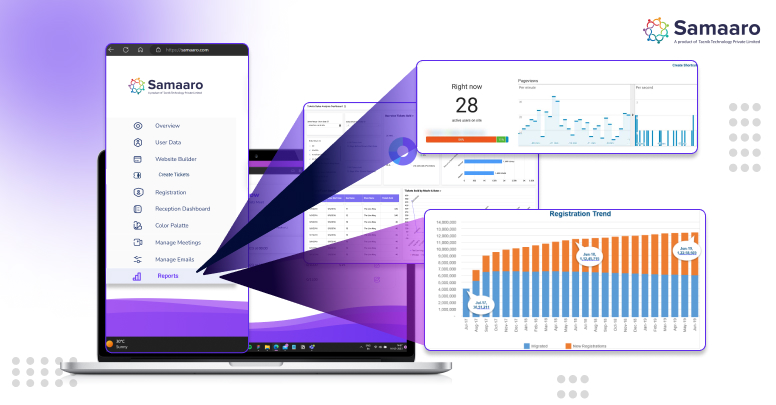
4. Gamify Lead Capturing
By gamifying the process, you can turn lead generation into an engaging experience. Instead of just putting business cards into a bowl, try scanning business cards or scanning QR codes to collect leads. Visitors who attend the event and scan QR codes at booths get points, and the top 100 participants are qualified to win prizes. This approach provides organisers with useful information such as popular booths and the average number of visitors to the exhibition halls. It also aids exhibitors in generating leads. This gamification feature will not only make lead generation more pleasant, but it will also inspire attendees to interact with sponsors.
5. Use AI Match-Making for Product Discovery
Use AI matchmaking to improve the attendance experience and drive more leads to sponsors. Create a product discovery tool that offers suitable products based on the interests and preferences of participants. Attendees are more inclined to investigate sponsor products that correspond with their needs when personalised suggestions are made, resulting in greater lead conversion rates. Further, attendees should also be able to search for products while applying necessary filters.
6. Pre-Event Meeting calendar
Before the event, set up a pre-event meeting calendar to allow participants to book meetings with sponsors ahead of time. Send out personalised “Book a Meeting” invitations through email or send engaging push notification that attract the audience, allowing attendees to reserve time slots with potential sponsors. This proactive strategy guarantees that sponsors spend one-on-one time with potential leads, resulting in more meaningful interactions and improved lead conversion rates.
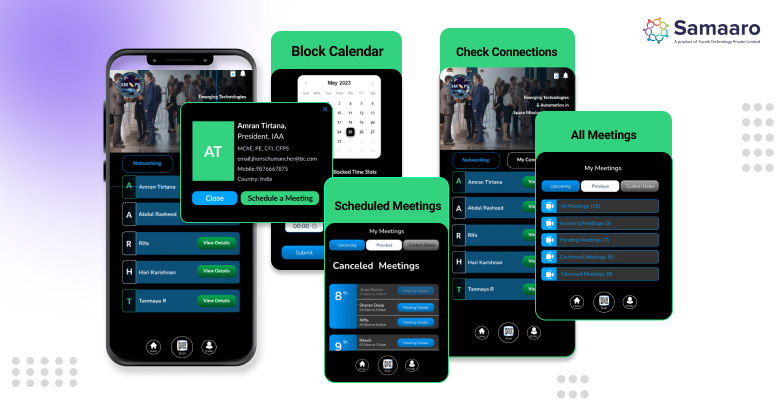
Remember that the relationships established, and the value created are at the heart of every successful hybrid event. By allowing sponsors to shine and engage guests in unconventional ways, you will generate a buzz that will last long after the event has ended. Attendees will recall the unique experiences and conversations, sponsors will value the leads and exposure, and your event’s status as a go-to industry meeting will be cemented.
So, include these ideas into your next hybrid event with Samaaro’s holistic solutions. Accept the endless potential of fusing the physical and virtual worlds, and watch as sponsors grow, attendees connect, and your event climb to new heights. Let’s work together to generate more leads, leave a lasting impression, and carve a successful route in the ever-changing world of hybrid events.
“80% of B2B customers make decisions based on the experience they have with each other. This is a clear indicator of how important networking can be for business.”
Networking is essential at every event, whether it is a conference, trade exhibition, or corporate gathering. It fosters exchanges of knowledge and the discovery of prospective business opportunities by facilitating connections among attendees. It is vital to give abundant networking opportunities in addition to creating an immersive event experience with modern technology, captivating exhibits, and recognised keynote speakers.
While participants may go home with prizes and instructional guides, the key to having a memorable and talked-about event is to provide compelling networking opportunities. Fortunately, the development of innovative technologies has greatly benefited event planners in making networking opportunities more accessible, convenient, and efficient, consequently connecting like-minded participants throughout the event lifetime.
In this blog we will delve into the benefits of networking at any event and have a look at some of the features that make the networking aspect in events smooth.
Expand your professional network: Networking allows you to broaden your professional circle, boosting your chances of discovering new employment prospects, partnerships, and possible clients. It allows you to access a larger pool of resources, knowledge, and skills.
Build relationships and enable collaborations: Events provide a platform for networking with peers in the field, potential mentors, and thought leaders. These connections can lead to collaborations, joint ventures, and useful insights that can help you advance in your profession or business.
Enhance personal and professional growth: Attending events with diverse professionals exposes you to new perspectives, ideas, and experiences. This exposure promotes personal and professional development by extending vistas and questioning assumptions.
Keep up with industry trends: Certain events frequently draw industry experts and thought leaders who share valuable insights and knowledge. Attending these events allows you to stay abreast of the latest trends, emerging technologies, and industry best practices.
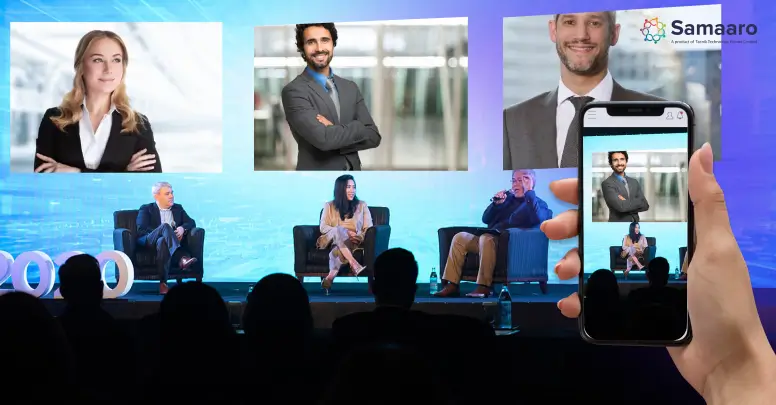
Matchmaking: Our matchmaking feature updates matches in real-time based on users’ previous connections and shared interests. For example, if you’re interested in machine learning, you’ll be shown a list of people who share that interest. Once you connect with individuals who are also marketers, the algorithm starts suggesting people who are interested in machine learning and are also marketers. This real-time updating ensures that you’re presented with more relevant connections, increasing the likelihood of finding meaningful matches.
Breakout Rooms: Breakout rooms allow for smaller, more concentrated talks among people who have common interests. Samaaro incorporates a breakout room feature, which allows attendees to join specific topic-based discussions. Event organizers can create and moderate these rooms, ensuring a conducive environment for networking and knowledge exchange.
Meeting Scheduler: Efficient scheduling is vital for maximizing networking opportunities. Build an easy-to-use meeting scheduler that allows attendees to schedule one-on-one meetings with other attendees. This feature is particularly useful in the pre-event phase, as it empowers users to plan their calendar effectively. Attendees can view the availability of other participants and identify potential time slots that align with their own schedule. Users can see each other’s availability and send meeting requests, which eliminates the need for back-and-forth communication and speeds up the networking process.
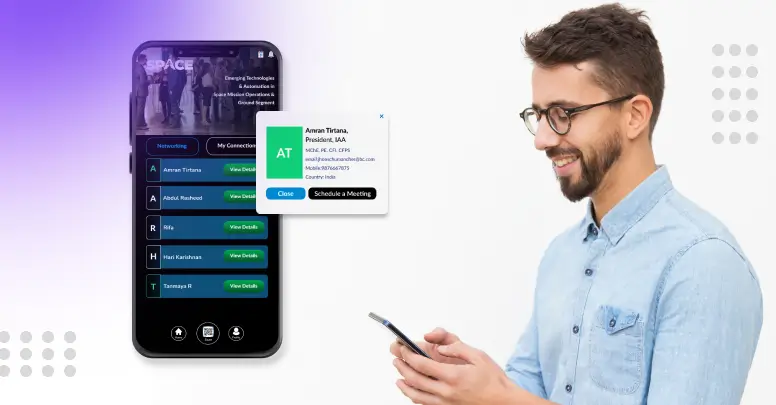
Business Card Exchange: The days of worrying about losing business cards are long gone. In a digital age, exchanging physical business cards may seem outdated. Instead, you can include a digital business card exchange feature that allows attendees to easily share their contact information. Users can scan one other’s QR codes or share information directly through the app, ensuring convenient and efficient information sharing.
Attendee Chat & Video Call: The inclusion of a chat and video call function within the event platform enhances networking by enabling real-time communication. This feature proves valuable before and after the event, allowing participants to connect and converse seamlessly. Prior to the event, it facilitates introductions, idea exchange, and relationship building. During the event, it enables immediate interactions, question asking, and deeper connections through face-to-face video calls. Post-event, it serves as a communication channel for ongoing engagement, resource sharing, and collaboration. Overall, this feature adds convenience, personalization, and effectiveness to networking experiences, fostering meaningful connections.
Group Activities and Games: Networking can go beyond the conventional formats. To foster engagement and collaboration, incorporate group activities and games. Attendees can take part in team competitions, virtual scavenger hunts, or icebreaker games, providing a fun and engaging environment that allows for comfortable networking and is a great icebreaker between attendees.
In conclusion, the value of networking during events cannot be emphasised. It acts as a catalyst for professional development, personal development, and the establishment of important connections that can have a tremendous impact on our lives. Individuals can manage events with confidence, establish discussions with ease, and build relationships that extend beyond the event itself by applying the approaches mentioned in this post. Networking, whether at a conference, seminar, or industry event, provides excellent opportunity to learn, collaborate, and create new possibilities. So, embrace the power of networking, get out of your comfort zone, and you’ll discover a world of limitless possibilities just waiting to be discovered. Always keep in mind that every connection you make can affect your future, both personally and professionally.
Sponsorship management is an essential part of any event. Sponsors do not just offer monetary assistance; they also enhance the experience and value provided to attendees. However, management of sponsorships can be a juggernaut for event organizers. Seriously! The complexity in identifying, negotiating, and fulfilling sponsorships adds to the challenges of event organizing. Event management software can solve many of these problems.
The best event management software is built to assist event organizers in developing and maximizing event planning and execution. Event management software is equipped with features and functions geared toward sponsorship management.
In the following sections, we will discuss the position of event management software with sponsorship management; we will discuss how event organizers are challenged by sponsorship management, how event management software resolves these challenges, and features that go toward resolving the sponsorship management process.
Sponsorship management consists of several key components that event organizers must be involved in with their sponsors for the collaboration to be successful. These include:

Event organizers need to identify sponsors whose organizational values are aligned the event’s purpose and target audience.
Event organizers need to perform research and analyse industry trends, while trying to understand the potential sponsor’s objectives.
Identifying and approaching sponsors without a process can be very cumbersome and consume a lot of time and resources.

Once potential sponsors have been identified, the negotiation takes place.
Event organizers and sponsors must come to agreements that are mutually beneficial, making sure to identify sponsorship price packages, Negotiations are not done in a vacuum; they consist of various participants, many contract terms, and many bespoke sponsorship options. A helpful tip is that if you are negotiating a sponsorship contract with your sponsors for an event, you should do so as a multi-year contract instead of just a single event by giving them more value.

Once the sponsorship contract is negotiated, it is time for the event organizer to fulfil the sponsorship deliverable agreements, which includes placing sponsor logos on the sponsorship material, providing space and booths, and executing promotional activities. This requires coordination, quick response times, and attention to detail.
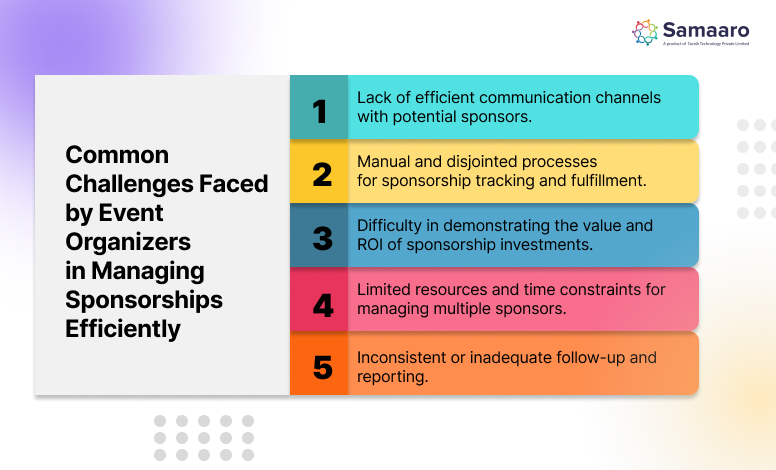
Event management software allows event organizers to address all these concerns with sponsorships by optimizing the efficiency of sponsorship management. Most event management software come with a one-stop shop platform that will simplify the sponsorship process for sponsors, which includes sponsor identification, negotiation, fulfilment, and tracking. This offers event organizers a more efficient and effective method of forging relationships with sponsors, while generating revenue (sponsors) and enhancing the overall experience for attendees.
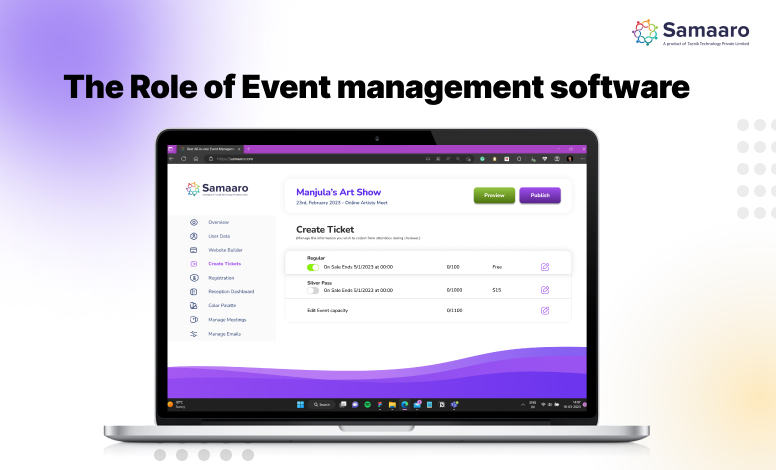
Event management software are comprehensive software platforms that are built to help simplify and optimize the various tasks involved in event planning and management. Event management software is useful for improving sponsorship management because they offer specific features and functions that have been developed to provide process and procedure efficiencies around sponsorship.
Simplifying event planning and execution
Event management software provides a central platform for everything event-related, including sponsorship management Centralization allows users to have an easier interface and simpler workflows overall, which contributes to a better planning experience.
Improved Sponsorship Management
Event management software offers modules or other functions dedicated to sponsorship management. These functions also allow users to prospect for sponsors, communicate with sponsors, and negotiate sponsorships more efficiently.
Customizable sponsorship tiers
Event management software allows event planners to customize sponsorship tiers based on different levels of sponsorship and the benefit to some level. Event planners can customize the tiers and benefit level and can assign those sponsorship levels and tiers with pricing levels to the event using software.
This level of flexibility allows event planners to customize sponsorships for registrants based on their own unique needs and outcomes.
Automated communication with sponsoring brands
Event management software offers communication tools that can make sponsors and planning committee members contact easier at the event. There are email template functions/builders, reminders, and then internal messaging functions built into the system for communication to avoid missing anything or communicating things late.
Automated reminders can help event planners to avoid unknown disappointments during events because they share/token things that will happen that sponsors can miss out on.
Sponsorship tracking/reporting
Sponsorship tracking and reporting capabilities are often in event management software. Most event management software offers some type of custom report/analytical function that can show sponsors value and sponsorship ROI for sponsorship functions later for both parties.
Integration with payment systems
Many events management software can integrate with Payment systems to track payments / to track payment invoices for sponsors. This allows for easier management in terms of payment processing, invoicing and budget-related tracking regarding sponsorships.
Overall these types of software provide many options to enhance events for both the event planner and sponsors by adding capacity functions, automatic functions and streamline processes. These solutions provide event organizations with the ability to effectively manage the acquisition of sponsorships, negotiations, fulfilment and reporting, improving relationships with sponsors and the overall impact of sponsored events.
Event management software can serve a critical function for event organizations by supporting the communication and engagement with sponsors. Event management solutions also feature functionalities that can allow event organizers to support the engagement of sponsors and provide a meaningful method to measure your return on investment (ROI).
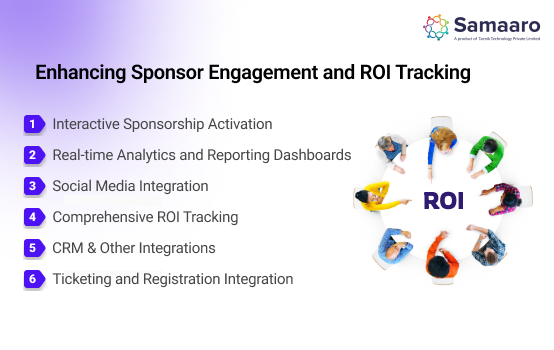
Real-time Analytics and Reporting Dashboards:
Event management software feature reporting dashboards and real-time analysis capabilities to track and measure the impact of sponsorship, reporting on both an event sponsorship presence and the overall sponsorship experience. Event management software will capture data on attendee interaction, engagement, conversion, impressions, clicks, registration, and lead generation. Reporting and dashboards that offer sponsors real-time reporting and visualization on activity and key performance indicators (KPI’s) will allow event organizers to be proactive to maximize sponsors ROI and showcase the value and impact of the sponsorship investment.
Social Media Integrations:
Event management software are integrated with social media functionality and allow sponsors the opportunity to leverage the reach ofThese integrations can take many forms, such as live social media walls, social media competitions, or hashtag-based campaigns. These types of activities encourage event participants to engage on social media and share their experiences, while giving sponsors a way to promote their reach, develop excitement, and effectively measure the impact of its sponsorships in relation to social media activities.
ROI Measurement :
You would be amazed at the power of event management software for measuring return on investment (ROI). They can encompass many forms of measuring, so that both the organiser and the sponsors can measure the success and impact of their sponsorships. Examples of ROI measuring include lead conversions, website traffic as a result of the event, social media engagement, and survey completions. Having this information in reports and analytics, an organiser can demonstrate to their sponsors the concrete outcomes of sponsorship expenditure.
CRM and other integrations :
The event management platform offers a great ecosystem for sponsors, where multiple tools contribute a unique capability for sponsors. Once incorporated with a CRM, the event management platform will seamlessly pull the attendee’s data into the sponsors CRM, therefore the leads and prospects will continue to provide one consistent place for storing their data. Generated leads and prospects will allow the sponsors to know where they had contact with potential clients and facilitate follow-up relationships post event as well as targeted follow-up campaigns. Furthermore, it might also wish to incorporate integrations for ECRM and marketing, to generate targeted lists for emails, personalized communications, automating their marketing, and providing insights through survey tools. With these tools integrated, all of these capabilities would empower list engagement, measure and data analyse ROI, grow sponsorship strategies, and improve overall investment decisions for future sponsors.
Ticketing and Registration Integration :
Many event management systems are ticketing systems. Therefore, sponsorship integration as part of the sponsors ticketing system will therefore not only trespasses to attendee registrations and ticket sales but provides insightful participant data too. This is particularly of value to a sponsor that is targeting a specific demographic of attendee.
Event management software is a streamlined process for sponsorship management capacity that minimizes duplication and offers an integrated process for planning, provision, and tracking through to sponsorship value enhancement that is beyond regular fulfilment and reporting for developing value for the sponsor and an ongoing relationship with that sponsor that maximizes the impact of the event.
Samaaro’s multi-dimensional event management software offers these possibilities through managing sponsorships in a streamlined way through integrated communications, planning and monitoring. Samaaro’s platform provides a fully immersed experience in real time with analytics, and sponsors social media, ROI, to engagement to sponsor, to maximizing overall event impact, we can ensure sponsorship management is effective, and impacts success within events
New studies show “B2B marketers are 31% likely to say event marketing is the most effective marketing channel.” Marketing through events is extremely useful for all businesses, such as technology businesses, educational institutions, non-profits, medical services, and retail products.
It was also reported, “52% of marketers believed event marketing has the most powerful return on investment.” Event marketing also promotes thought leadership and industry knowledge, brand recognition, and more.
Now that we understand how impactful event marketing can be, to get the most out of your participation in events and how to utilize the events, you need to build an effective strategy on the marketing effort covering the pre-event, during-event, and post-event activities.
Set goals: Understand why you are attending and what you hope to achieve with the event. Do you want to improve revenue, brand recognition, or lead generation? Your marketing efforts are fuelled by defined targets and can easily track progress.
Create compelling content: Content raises excitement about an event and informs value. This could be emails, videos, social media teasers, and blog postings. Use storytelling techniques to captivate your audience and give a teaser of what is coming.
Use social media: Social media platforms are effective tools for event marketing. Make a hash tag for the event, show behind the scenes images, and encourage attendees to share. Post contests, polls, and live Q&As to engage the audience and build
This article will discuss some effective event marketing tactics to generate excitement, boost attendance and connect with your attendees, everything from a snazzy landing page to social media ads. There are a lot of strategies to explore.
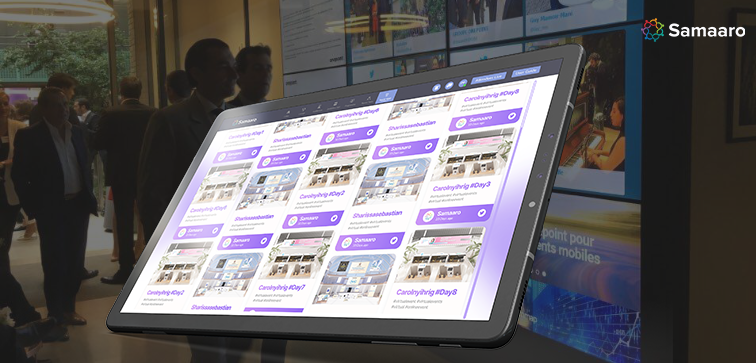
Develop interactive activities to connect with attendees: the idea of an event is to provide something worth experiencing for your attendees. Keep attendees engaged by adding some interactive activities to allow attendees to connect with other attendees on a deeper level; you can use live polls, Q&A, gamification, etc, to connect attendees. You might even have an Instagrammable moment for attendees to share a snapshot of their experience at the event, to help keep them engaged with the experience. Consider providing a photo booth where attendees can take pictures to keep them connected to the experience.
Live stream, and virtual attendees; in the age of hybrid events, use live streaming at your event to help enlarge your audience size. Tweet about it, use hashtags, and engage with your live chats during the event to elevate participation with your online attendees. Think about offering unique digital content to your audience, so they can also enjoy a level of experience.
User-Generated Content; be sure to inform attendees of the event hashtag, so they can take to social media, and share their experience at the event as it happens, with their friends, as the event is occurring. This also empowers attendees to reach a larger audience and adds true testimonials at your event. You might even create contests or incentives for the best user-generated content.
Summarize, and share highlights; after the event, summarize the event with blog posts, or video and social media updates that highlight a few key takeaways from the event and highlight memorable moments that the attendees can recall, as part of the experience. This extends the life of the event and hopefully promotes actions from those who didn’t attend the event.
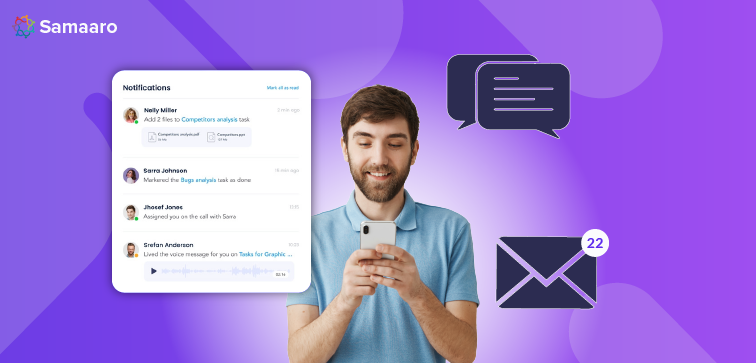
Kick off with a dedicated Event Landing Page
Creating a page dedicated to the aesthetics and concept of your event is a simple but extremely effective tactic. This page will be a powerful tool because it will consistently generate the collection of those interested in attending your event, leading to an increased level of rsvp’s. Samaaro offers a large library of ready-to-use templates tailored to your event’s theme. Beyond design customization, it helps you engage diverse audiences, extend your reach, and maximize impact, with all content optimized for SEO.
To create a landing page that converts the visitor to attendee effectively, the platform should do the following things:
Create an Email Marketing CampaignEmail marketing is consistently regarded as one of the best forms of event marketing. Event organizers often leverage email as an effective tool to communicate with their targeted audience. Email marketing allows you to establish a relationship with potential registrants during the registration phase and nurture registrants right up leading to the event date. Conversely, you can send newsletters reminding attendees of the event with two distinct methodologies: you can send a more informational email to update registrants with things they need to know between registration and the actual event, or you can send a more fun and engaging email to stimulate interest and excitement leading into actual event. Try using a compelling subject line to prompt the user to click the open the email. Even simple subjects like “You won’t want to miss this” can create a ton of excitement and buzz leading to the event. Engage Attendees into Event with 360 notifications Increase the potential for engagement, regardless of the type of event you’re managing whether it is in-person, online or hybrid, it’s important to accommodate the fact that event participants have busy lives and times when they forget about certain sessions or information, they meant to engage in. While it may be helpful to provide each event attendee with their own customized schedule of events, it is also important to have an ability to push notifications via email or through a mobile event application to remind registrants when sessions start, and encourage participants to participate in wellness or gamification exercises that are scheduled outside of the traditional sessions.
Social media above all things is a solid way to make noise about the event. Today when there is more than 3.8 billion people are active on various social networks, it is apparent that it only makes sense to leverage the multiplied of channels where your targeted audience engages with their social media presence.
There are several ways to leverage social media to market your event. You can leverage Instagram with posts and captivating videos and clips, you can establish Facebook pages specific to your event, get a brand or event specific hashtag to start a compilation of all of your own social media content and establish a different lead driven marketing strategies to target some audiences on platforms, while also thinking about how to generate content.
This is your opportunity to build marketing strategies beyond just social media, while still utilizing your social media to engage social media followers. Leverage some of the AI models that the world is shifting towards to generate content for your event. You can engage your event collaborator including the co-hosts and speakers to create cross-promote for shared social media efforts.
Swag Bags
So finally, possibly one of the more important points might be rooting collaborating with branded swag providers to market your brand and present attendees with a gift for coming to your event, let’s be honest everyone likes free stuff! There are almost limitless options for making a great swag bag. The key is to include a plethora of cost effective free branded items at once, whether they are simply in plastic bags, tote bags, or whether you think outside the box and get creative with some alternative vessels for swag like baskets, bowls or crates! Who isn’t tempted by a quality branded mug or koozie?
Based on a survey, it has been found, “34% of event professionals plan to use the hybrid format for the majority of their events in 2023.” This demonstrates the increasing prominence of mixing in-person and virtual elements in the event sector. Organisers can reach beyond their physical restrictions through hybrid events. They can cater to a bigger audience by allowing people who are unable to attend in person due to distance, travel restrictions, or other factors to participate virtually. Sponsors also stand to gain significantly from hybrid events, as they obtain more exposure for their brand across two unique platforms, resulting in equal benefits on both fronts.
Having said that, effectively engaging attendees at hybrid events poses significant challenges. A hybrid event can provide distinct experiences to broad groups by incorporating both styles, but at the same time, it entails investing twice the effort in crafting distinct participant experiences, catering to both on-site and remote participants. Regardless of the event type, ensuring participants feel included requires active engagement with them. The above statistics show that hybrid events have grown in popularity in recent years, as they offer the best of both worlds. In this blog post, we’ll look at five trending features for hosting effective hybrid events that attract and engage your audience.

The introduction of photo booths in hybrid events expands the opportunity to create lasting memories that extends beyond just in-person attendees to virtual guests as well. Hybrid event platforms enable organizers to create a visually appealing photo booth area at the physical event location, complete with artwork, backdrops, and professional lighting, catering to the in-person audience.
Simultaneously, an online photo booth can also be enabled that allows virtual guests to click and post their own photos with a variety of backgrounds, frames & filters. Moving forward, an attractive photo gallery can be created to display all the pictures posted by both in-person and virtual attendees. This will help build a delightful sense of community where attendees can have access to like and comment on pictures posted by everyone.
This feature encourages conversation, networking, and a sense of support among players, regardless of whether they are present on-site or joining electronically. Attendees get the opportunity to make relationships through face-to-face interactions and mutual recognition.
Incorporate a virtual treasure hunt into your hybrid event to provide an intriguing and challenging experience. Use a dedicated event app or web-based platform that allows participants to participate in riddles, find clues, navigate spaces, and earn rewards.
This interactive activity fosters a sense of competitiveness and camaraderie among participants by encouraging exploration, teamwork, and the development of problem-solving skills. It not only allows participants to have fun during the event, but it also helps them collect prizes and achieve recognition on the leaderboard as they successfully navigate the treasure hunt.

In B2B conferences and workshops, a leaderboard for attendees would be highly valuable, allowing organizers to identify their most engaged attendees, customers, or new prospects. Gamification is a powerful tool for driving engagement, and an activity leaderboard adds a healthy dose of competition to your hybrid event. Create a leaderboard that tracks and displays the progress and accomplishments of attendees throughout the event.
Points can be awarded for a variety of activities, such as attending sessions, engaging in conversations, visiting booths or completing challenges. The real-time leaderboard could be visible both at the physical event location and on the virtual event platform, encouraging attendees to participate actively in order to secure a spot on the scoreboard.
Social media plays a substantial role in event marketing by increasing event awareness. Utilize the power of social media by incorporating interactive challenges that encourage participants to connect with and share event-related content. Create unique tasks, such as photo-sharing, event update dissemination, or active participation in event hashtags. Participants that actively contribute should be rewarded with unique items, discounts, or VIP access to future events.
This feature not only increases the event’s visibility on social media but also builds a sense of connection and excitement among participants. Consider including a Q&A session or a live social wall during your hybrid meetings as well. Allow both virtual and in-person attendees to submit questions or tag you on social media in order to appear in the live feed.
Rather than relying on pop-ups for merely sales, a more productive strategy involves integration of pop-ups allows participants to get involved in a variety of activities like contests, networking lounges, and demo sessions. You may also choose to include interactive and fascinating pop-up games in the event that can also provide moments of enjoyment and relaxation.
Word finder puzzles, image puzzles, trivia quizzes, and mini-games can be smoothly integrated into session breaks or designated game zones at the event venue. Further, the games can be made available to virtual participants via the event app or website. These activities provide a refreshing break, fostering an atmosphere of relaxation, socialization, and enjoyment, thereby promoting engagement among individuals.
You can build immersive and engaging events that bridge the gap between virtual and in-person attendees by using technology and innovative concepts. As hybrid events become the norm, incorporating these significant traits will allow you to stay ahead of the curve and provide exceptional experiences that will leave a lasting impression on both virtual and in-person attendees. Embrace the power of Samaaro’s engagement features and unlock the full potential of your hybrid events to foster connection, collaboration, and inspiration in a rapidly changing digital landscape.
Not long ago, we found ourselves completely involved in the fast-evolving world of events. But as technology advanced at an unprecedented pace, so did the realm of events. The rise of artificial intelligence (AI) has now taken center stage in the industry, revolutionizing the experience for organizers, speakers, and attendees alike. AI can manage every aspect of the event. It might begin with duties like as booking, ticketing, and determining a target audience. It can also manage a variety of activities throughout the event, such as participation and exit processes. Event organizers can use AI to provide a seamless and trouble-free experience for both guests and organizers.
Although when speaking of AI in events, the current buzz revolves around AI powered matchmaking, which connects event attendees with shared interests; nevertheless, it is necessary to recognize that AI offers much more than that. Open AI’s ChatGPT, a strong tool for generating event content, is one outstanding example. Chatbots have also emerged as game changers, revolutionizing attendee assistance. Chatbots automate the entire process rather than depending on a team of individuals to address repetitive inquiries. They not only answer frequently asked queries, but they also categorize users based on their roles.
In essence, artificial intelligence (AI) technology is set to turn events into more immersive and personalized experiences. In this blog, we will delve into ways in which AI may provide valuable support across the event lifecycle, including the planning phase, the ideation process, and post-event activities.
Through numerous functionalities such as call analysis, automatic follow-ups, data insights, and more, Artificial Intelligence (AI) can give essential support in project management at events. AI can extract key insights, identify action items, and capture important details stated during the discussion by analyzing these conversations.
Moving on, it can generate high-level summaries of fundamental points, decisions, and actions discussed during meetings or presentations, allowing project managers to quickly assess vital data without having to read through the entire content. AI algorithms can give actionable information, such as highlighting attendee sentiment, preferences, or areas for improvement, allowing project managers to make informed event planning decisions.
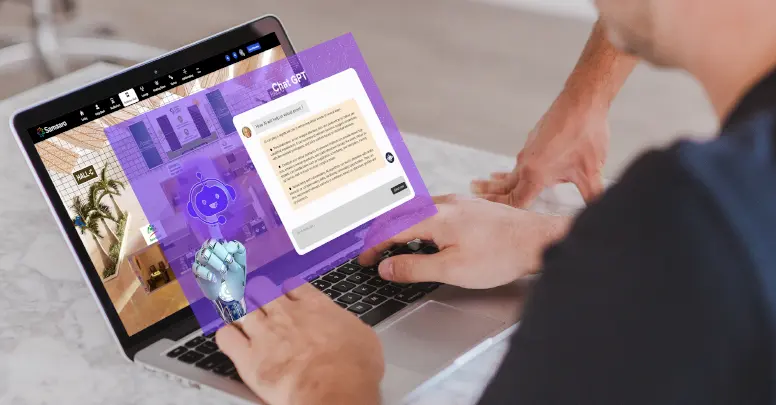
Hosting events on trendy and current issues that captivate everyone’s attention is a desirable goal for many. However, deciding on the best topic to write about might be difficult. This is where Artificial Intelligence (AI) can come in handy. AI can search social media networks like Twitter and LinkedIn for threads or debates that are generating a lot of participation and attention. The number of likes, comments, and shares on these threads, as well as their relation to the event’s theme, can be analyzed by AI algorithms.
Additionally, AI-powered technologies may analyze and collect input from a variety of sources, including surveys, social media platforms, online forums, and feedback forms. These comments can be collected and organized in spreadsheets for further examination. Relevant keywords, sentiment, and other data can be extracted allowing event organizers to gain valuable insights.
AI models, such as OpenAI, can be used to help in session ideation for any event by providing prompts for subjects, content goals, writing styles, and more. AI may assist in determining the goals and objectives for each session. It can, for example, benefit in choosing whether a session’s goal is to educate, entertain, inspire, or generate conversation. In terms of session structure, AI can help develop the format and organisation of the session. It can advise on the best duration, order of activities, and balance of presentations, discussions, and interactive aspects.
AI can help you determine the best writing style and tone for session materials including presentation slides, handouts, and promotional text. This combination between human expertise and AI aid allows for the design of interesting and effective sessions that resonate with participants and contribute to the event’s overall success.
AI may help with speaker selection for any event by extracting YouTube transcripts, analyzing speech coherence, summarising key topics, and determining the acceptability of speakers. For example, AI can obtain a written representation of the speaker’s presentation or discussion by analyzing the spoken content. AI can provide automatic summaries of the speaker’s important points, emphasizing the key takeaways from their lectures. This can let event organizers swiftly assess and compare the material of different speakers, easing the decision-making process.
AI can also analyze a possible speaker’s internet presence, social media involvement, and industry reputation, which speeds up the speaker selection process, ensures the selection of engaging and informed speakers, and contributes to a successful and impactful event.
Event companies frequently face the difficulty of making sense of the massive amounts of data generated by events. However, the incorporation of AI techniques makes collecting and analyzing feedback significantly easier. AI solutions can help automate the collection of feedback data and organize it in a spreadsheet-style for easy analysis. These solutions go beyond simple data collection by allowing event organizers to ask specific questions, refine data, and derive deeper insights.
Furthermore, AI-powered solutions such as ChatGPT may effectively summarise feedback data, providing the essential findings in a simple and simply digestible list. Event organizers may improve future events by integrating AI technology to streamline feedback collecting, improve data analysis, and obtain important insights.
In conclusion, AI may be a helpful ally in the event ideation process, whether it’s creating session ideas, setting content goals, recommending writing styles, or increasing audience engagement. Organisers may create memorable and impactful events by combining human creativity and skill with AI-powered support. With the integration of these tools and the flexibility and scalability of Saamaro, you can host events like never before!
Virtual Exhibition have gained immense popularity in recent years, especially with the advent of the pandemic. With businesses and organizations moving online, Virtual Exhibition have become a preferred option to showcase products and services. They offer a unique opportunity to connect with a global audience and provide a platform to display products to potential customers, without the limitations of physical space.
In this article, we will delve into the world of Virtual Exhibition and explore how businesses and organizations can creatively showcase their products in these digital spaces. We will discuss the importance of product showcasing in Virtual Exhibition and provide insights into how to make the most of this online medium. With Virtual Exhibition becoming a norm, it is imperative for businesses and organizations to adopt innovative ways to showcase their products and services. By the end of this article, readers will have a better understanding of the creative ways to showcase products in a virtual exhibition, and the potential benefits of product showcasing for their business or organization.
Virtual Exhibition have emerged as a popular alternative to traditional physical exhibitions, offering convenience and accessibility for businesses and attendees alike. However, with the absence of physical interaction, it becomes crucial for businesses to showcase their products in a virtual environment to engage potential customers and drive sales. Product showcasing in Virtual Exhibition can create an immersive and interactive experience, leaving a lasting impression on customers and ultimately leading to increased brand awareness and loyalty.
Virtual Exhibition have become increasingly popular due to their convenience and accessibility. However, without physical interaction, showcasing products effectively in a virtual exhibition becomes crucial to engage potential customers and drive sales. By using high-quality images, videos, and 3D models, businesses can present their products in an interactive and visually appealing way, providing potential customers with a better understanding of the product, which ultimately leads to increased engagement and sales.
Product showcasing in Virtual Exhibitions is a powerful tool that can boost sales, drive engagement, and provide valuable data analytics for businesses. By showcasing products in an immersive and interactive manner, businesses can create a memorable experience for their customers, leading to increased brand awareness and customer loyalty. One of the key benefits of this approach is lead generation, as providing visitors with an opportunity to engage with products in a virtual setting allows businesses to capture their interest and gather valuable information about their preferences and behaviors. This data can then be used to tailor marketing strategies and improve customer experiences, ultimately driving sales and growing the business.
Compared to traditional physical exhibitions, Virtual Exhibition offer several advantages, such as reduced costs and increased accessibility. However, product showcasing remains a critical component for success in both types of exhibitions. While physical exhibitions provide the opportunity for customers to physically interact with products, Virtual Exhibition offer a unique opportunity to showcase products in an interactive and visually appealing manner, leading to increased engagement and sales.
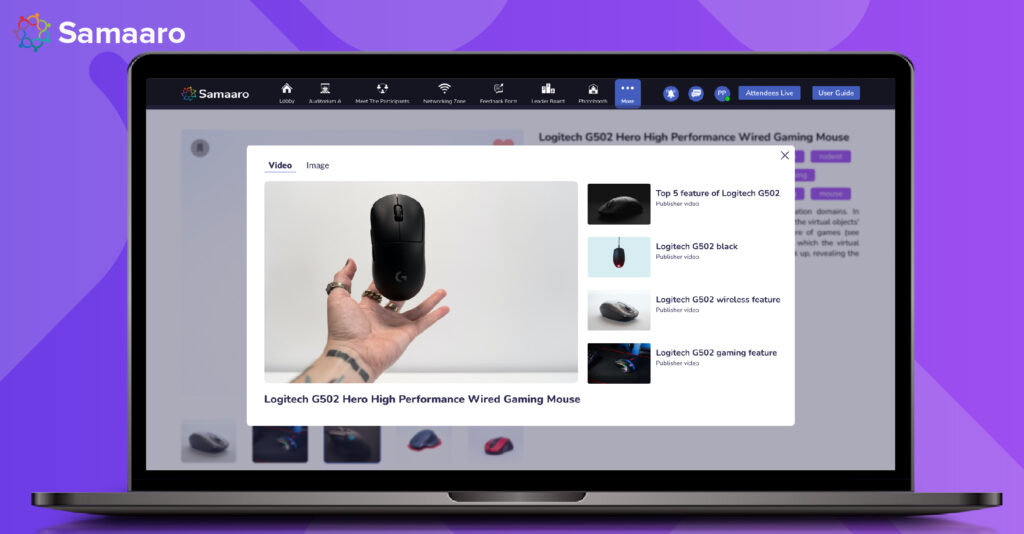
When it comes to showcasing products in a virtual exhibition, it’s essential to choose the right approach that fits your business needs and objectives. There are different types of products showcases that businesses can consider, depending on the nature of their products and the desired level of interactivity.
In Virtual Exhibition, there are various approaches to showcase products effectively. Some of the most common types include:
Here are some factors to consider when choosing the right showcase approach for your products in a virtual exhibition:
By considering factors such as the type of product, target audience, budget, technical requirements, brand image, level of interactivity, and compatibility with the virtual exhibition platform, you can choose the showcase approach that best highlights your products and resonates with potential customers.
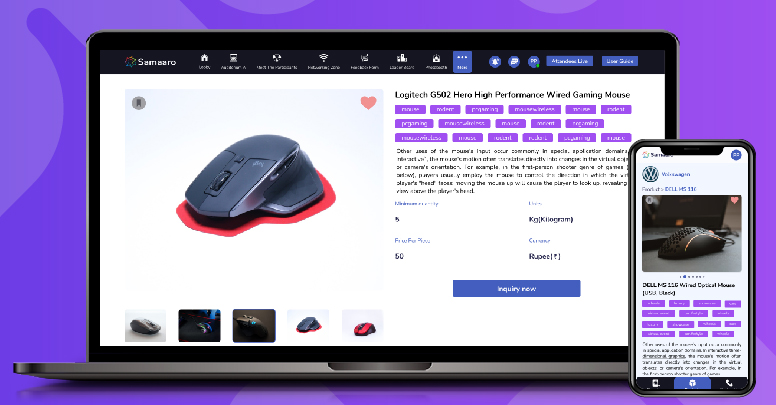
In today’s digital age, creating an immersive product showcase has become an essential component of successful marketing strategies. To achieve this, businesses must focus on designing an attractive and user-friendly virtual booth that incorporates interactive features and gamification to engage visitors.
When designing a virtual booth, it’s crucial to ensure that it is visually appealing and easy to navigate and displays your brand. The following are some ways of achieving this:
Utilizing interactive features is another way to make your product showcase more engaging. Here are some ways to do this:
(Note: Features like 3D walkthrough and Virtual Walkthrough can be implemented in property exhibitions to enhance the overall experience of the attendees)
Gamification is another way to engage visitors and make your product showcase more memorable. Some gamification ideas include:
Incorporating social features is another way to encourage visitors to engage with your virtual booth. Some examples include:
By designing an attractive and user-friendly virtual booth, incorporating interactive features and gamification, and incorporating social features, businesses can engage visitors and increase brand awareness and is vital component of modern marketing strategy.
Even if it is a virtual exhibition, businesses should not forget about the little but extremely important detail – i.e., human touch. Personal interaction is crucial for creating a positive customer experience, and it’s essential for businesses to find ways to add a human touch to virtual product showcases.
Virtual Exhibition offer businesses and organizations a unique opportunity to showcase their products and services to a global audience, without the limitations of physical space. Product showcasing is critical to engage potential customers and drive sales. Samaaro, an event technology platform, provides all the necessary tools and integration for an excellent product showcasing experience in Virtual Exhibition. By using high-quality images, videos, and 3D models, and virtual event technology, businesses can create an immersive and interactive experience that leaves a lasting impression on customers. Choosing the right product showcase approach is crucial, and factors such as the type of product, target audience, budget, technical requirements, brand image, level of interactivity, and compatibility with the virtual exhibition platform should be considered. With the increasing popularity of Virtual Exhibition, businesses and organizations need to adopt innovative ways to showcase their products and services, and Samaaro can help achieve this. So, start using Samaaro to showcase your products effectively and stand out in the virtual exhibition space.
The best way to streamline the time-consuming registration and queue procedures outside event locations is by considering an all-in-one event ticketing solution to assist event registrations. Curious about the operational mechanics? It’s simple: the event technology platform reduces the burden of event planners and commercial entities while also providing attendees with a seamless and painless experience. Before we get into the practicalities of event ticketing, let’s first understand it.
When you go to a trade show, conference, or event, the main aim is to get people to meet, make new connections, and share ideas. This is done by giving out tickets or badges to people who register and provide their information. These tickets let them into the event.
Typical features of this type of system include online ticket sales, attendee check-in, payment processing, and reporting/analytics capabilities. Organisers may streamline their operations, improve the attendance experience, and raise the success of their events by utilising an event ticketing and registration solution.
As for an in-person event, an event landing page is initially built to generate hype and assist with registration. This method allows guests to pre-register for the event, with their information stored on the website. We, at Samaaro, understand how each event is unique and work closely with the clients to build custom landing page for each event.
The ticketing alternatives for an event differ depending on whether it is free or paid. Scan a QR code upon admittance to the event to track attendee presence and outreach. Using an optimum event registration platform, along with its associated event registration and ticketing solutions, avoids the difficulties of long wait periods and queues, as well as the possibility of technical and informational complications.
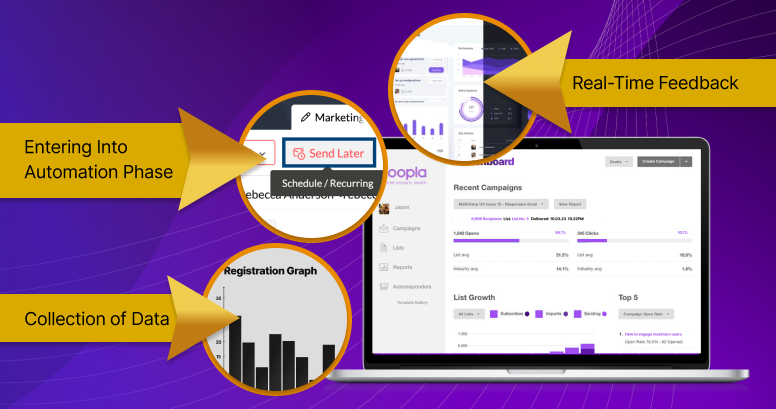
Event technology platforms provide a seamless experience, attendees can easily register for events, purchase tickets, and access event information anytime, anywhere, from any device. Attendees can enter their information, choose ticket types, and make secure online payments with a few clicks, increasing ease and accessibility. Guests can be given personalised registration forms that collect useful data, delivering a personalised experience from the start. For example, a color-coded ticket system could be used to distinguish between vegetarians (green ticket) and non-vegetarians (red ticket). Similarly, a silver pass may just allow admission to the exhibition and conference spaces, whereas a gold pass may allow access to all areas, including networking possibilities.
With the advent of event registration and ticketing systems, businesses and event organizers no longer need to collect data manually prone to human errors. With the help of event registration software, all event-related information can now be compiled in a single area that is easy to navigate. This includes information about registrations, attendance, number of check-ins, check-outs and time spend in the event, and areas navigated by the attendees.
Event registration platforms provide event organizers with expanded marketing capabilities such as targeted email campaigns, social media promotion, personalized landing pages, and analytics and reporting. These methods aid in raising event awareness, engaging participants, and driving attendance. Organizers can create a personalized and successful event experience by utilizing these elements.
Event registration and ticketing can significantly minimise the time and effort required to operate an event by removing the need for manual registration entry, bill and receipt printing, and phone or email communication. You may save time and money by utilising the power of an online solution instead of printing registration forms and event materials. Businesses can optimise resource allocation, eliminate human error, and reach higher productivity levels by substituting manual labour with automated operations.
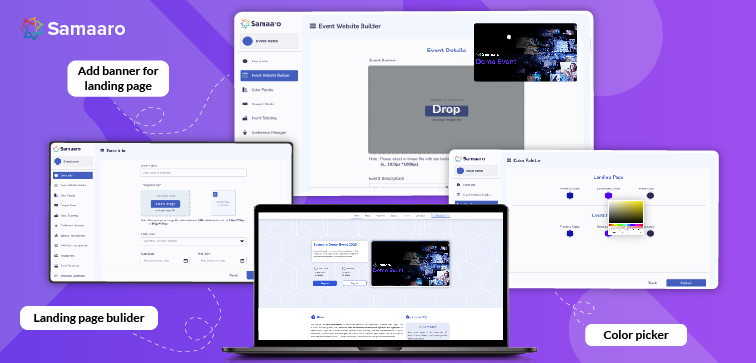
In conclusion, online registration and ticketing systems provide various benefits to event organizers, such as convenience, increased attendance, increased revenue, streamlined check-in, and enhanced marketing capabilities. Businesses and event organizers can produce more effective events that are easier to execute and more profitable by utilizing these solutions.
If you’re planning an event, consider using an online event registration and ticketing solution for your in-person, hybrid, or virtual events to help it succeed – Samaaro is an all-in-one event technology, user-friendly, and resilient platform that offers a variety of event registration and ticketing options, making it suitable for events of all sizes. The dependability and security features of the platform ensure that your event runs well, decreasing the potential of technical issues or security breaches. You can be confident that your event registration and ticketing needs will be addressed to the highest standards when you use Samaaro.
In-person events have always been a great way to connect with like-minded individuals, network, and build business relationships. However, as technology continues to evolve, event planners are finding new ways to enhance the attendee experience using event technology. In this article, we will explore the benefits of event technology for in-person events, the types of event technology to consider, and the role of data in optimizing events. We will also discuss important factors to consider when choosing event technology, expert tips for implementation, and the future of event technology.
From streamlining event planning to enhancing the attendee experience, event technology offers a multitude of benefits. Here are some of the benefits of using event technology for in-person events:
There are many different types of event technology to consider for in-person events. These include:
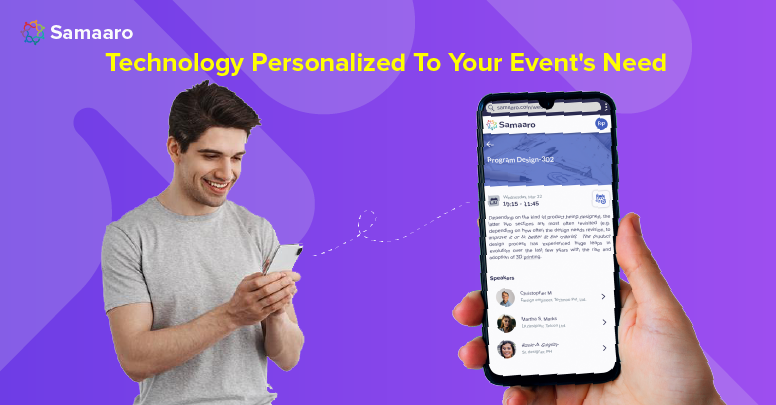
One of the primary benefits of event technology is its ability to improve attendee engagement. By providing interactive features, personalized content, and real-time engagement, event technology can create a more immersive and enjoyable event experience.
Ways in which event technology improves attendee engagement:
Data is a crucial component of event optimization. By collecting and analyzing data on attendee behavior, preferences, and engagement, event planners can identify areas for improvement and make data-driven decisions about future events.
Below listed are some points that lay out the role of Data in Optimizing In-Person Events
By leveraging data to optimize in-person events, event planners can make informed decisions, provide personalized experiences, and ultimately create more successful events.

By carefully considering these factors when selecting event technology, event planners can ensure that they choose the right software to meet their specific needs and help optimize their in-person events.
To ensure successful implementation of event technology at your next event, consider the following expert tips:
Event technology is constantly evolving, and its potential impact on in-person events is immense. Some researched and predicted potential future developments in event technology can include:
In conclusion, event technology has revolutionized the way in-person events are planned and executed. By incorporating technology into your events, such as Samaaro’s all-in-one event technology platform, you can increase attendee engagement, streamline planning processes, and generate valuable data to optimize future events. Samaaro offers features like registration, live streaming, virtual networking, and audience engagement tools that can help you create a seamless and engaging event experience for your attendees. Additionally, its user-friendly interface and excellent customer support make it easy to use and ensure a successful event. When choosing event technology, consider your goals, audience, and important factors such as cost and compatibility. With the continued evolution of event technology, the possibilities for enhancing in-person events with platform like Samaaro are endless.

Built for modern marketing teams, Samaaro’s AI-powered event-tech platform helps you run events more efficiently, reduce manual work, engage attendees, capture qualified leads and gain real-time visibility into your events’ performance.
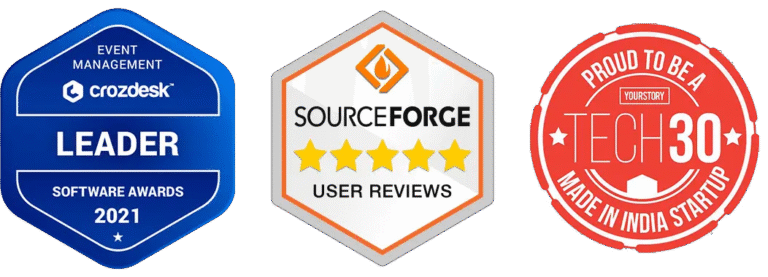
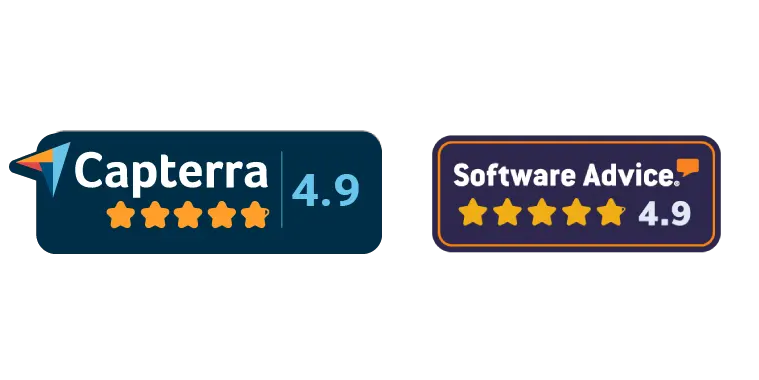
© 2025 — Samaaro. All Rights Reserved.